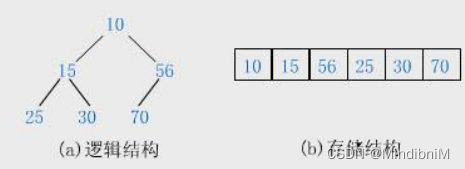堆的实现与操作
一.堆的结构
1.物理结构
typedef int HPDataType;
typedef struct Heap
{
HPDataType* a;
int size;
int capacity;
}Heap;
堆一般用数组来存储
有两种主要类型的堆:最大堆(Max Heap)和最小堆(Min Heap)。
-
最大堆(Max Heap): 在最大堆中,父节点的值始终大于或等于其子节点的值。这意味着堆的根节点是具有最高优先级的元素。
-
最小堆(Min Heap): 在最小堆中,父节点的值始终小于或等于其子节点的值。这意味着堆的根节点是具有最低优先级的元素。
2.逻辑结构
堆的逻辑结构是一个完全二叉树(Complete Binary Tree),这意味着除了最后一层外,其他层都是完全填充的,而且最后一层的节点都尽可能靠左排列。
类如这是一个小堆
二.堆的操作
在学习堆的操作前.我们需要学习调整算法
调整算法
1.向上调整
void AdjustUp(HPDataType* a, int child)//要调整的数组和要调整的数的下标
{
assert(a);
int parent = (child - 1) / 2;//找到这个数的父亲节点的下标
while (child > 0)
{
if (a[child] < a[parent])//这里是实现小堆,
{
Swap(&a[child], &a[parent]);//交换这两个数
child = parent;
parent = (child - 1) / 2;//向下走
}
else
{
break;
}
}
}当堆的某个节点的值发生变化,可能破坏了堆的性质(最大堆或最小堆),需要通过向上调整来修复。向上调整一般用在插入中.将这个数调整到堆里合适的位置.使得整个是一个堆
2.向下调整
void AdjustDown(HPDataType* a,int size, int panest)//要调整的数组和数组元素数和当前要调整的数下标
{
assert(a);
int child = panest * 2 + 1;//找到左孩子
while (child a[child + 1])//***
{
child++;选取左右孩子小的那个
}
if (a[panest] > a[child])//***
{
Swap(&a[panest], &a[child]);
panest = child;
child = panest * 2 + 1;
}
else
{
break;
}
}
} 当堆的某个节点的值发生变化,可能破坏了堆的性质(最大堆或最小堆),需要通过向下调整来修复。向下调整一般用于删除
1.堆的初始化
void HeapInit(Heap* hp)
{
assert(hp);
hp->a = NULL;
hp->size = 0;
hp->capacity = 0;
}与顺序表的初始化类似
2.堆的销毁
void HeapDestory(Heap* hp)
{
assert(hp);
free(hp->a);
hp->size = 0;
hp->capacity = 0;
}与顺序表的销毁类似
3.堆的插入
void HeapPush(Heap* hp, HPDataType x)
{
assert(hp);
if (hp->size == hp->capacity)
{
int newcapacity = hp->capacity == 0 ? 10 : hp->capacity *2;
HPDataType* arr = (HPDataType*)realloc(hp->a,sizeof(HPDataType) * newcapacity);
if (arr == NULL)
{
perror("realloc:");
exit(-1);
}
hp->a = arr;
hp->capacity = newcapacity;
}//扩容
hp->a[hp->size++] = x;
AdjustUp(hp->a, hp->size - 1);
}堆的核心就是调整算法,向尾插入数据后.调整堆
4.堆的删除
void HeapPop(Heap* hp)
{
assert(hp);
assert(hp->size > 0);
Swap(&(hp->a[0]), &(hp->a[hp->size - 1]));
hp->size--;
AdjustDown(hp->a, hp->size, 0);
}堆的删除是删除堆顶数据.我们把堆顶元素和尾元素交换,然后有效数据个数减小1.在将交换到堆顶的元素向下调整
5.取堆顶数据
HPDataType HeapTop(Heap* hp)
{
assert(hp);
assert(hp->size > 0);
return hp->a[0];
}6.堆的数据个数
int HeapSize(Heap* hp)
{
assert(hp);
return hp->size - 1;
}7.堆的判空
int HeapEmpty(Heap* hp)
{
assert(hp);
return hp->size == 0;
}
三.使用堆进行排序
1.向上调整建堆排序
void HeapSort(int* arr, int size)
{
for (int i = 0; i < size; i++)
{
AdjustUp(arr, i);
}
int n=size-1;
while (n>0)
{
Swap(&arr[0], &arr[n]);
AdjustDown(arr, n, 0);
n--;
}
}模拟堆的插入.调整数组里每一个元素建堆
每次取堆顶元素与最后一个元素交换.直至结束
2.向下调整建堆排序
void HeapSort(int* arr, int size)
{
for (int i = (size - 1) / 2; i >= 0; i--)
AdjustDown(arr, size, i);
int n = size - 1;
while (n > 0)
{
Swap(&arr[0], &arr[n]);
AdjustDown(arr, n, 0);
n--;
}
}从第一个非叶子节点开始调整,调整数组元素建堆,,使用局部最优达到全局最优的解法,这个方法比上一个效率更高
3.TopK问题
比如我要在1000万个数中选取最大的前K个,这时使用排序再选出就比较浪费时间,我们可以建立一个有k个元素的小堆,先将前k个建堆,
for (int i = 0; i < k; i++)
{
fscanf(file, "%d", &arr[i]);
AdjustUp(arr, i);
}
int x;
while (fscanf(file, "%d", &x) != EOF)
{
if (x > arr[0])
{
arr[0] = x;
AdjustDown(arr, k, 0);
}
}这里使用了文件读取数,先建立容量为K的小堆,然后再向后面读取数,如果数更大,就入堆向下调整
直至所有数据.那么堆就是由最大K个数组成的堆.
int n = k - 1;
while (n > 0)
{
Swap(&arr[0], &arr[n]);
AdjustDown(arr, n, 0);
n--;
}最后选最大数排序到后面.就找到了这K个数
时间复杂度为 O (N*log K)
近似 O(N)
